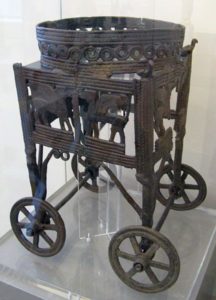 Multiple examples of bronze wheeled carts or stands have been found in Cyprus, most unprovenienced (not found in a controlled archaeological excavation) but attributed to the 12-10th c. These Cypriot examples stand approximately 3 feet high. While the specific decoration and exact proportions differ, each stand has the same combination of features. A rectangular base sits on 4 bronze wheels demonstrating that the cart was intended to be mobile. The bases feature scenes in one or more tiers with cherubim, other animals, palm trees or stylized trees/bushes, or elite activities, as in this case where two men with instruments stand before a seated woman playing a lyre. The round metal band rising above the rectangular base probably secured a bowl presumed to hold liquid though smoldering incense is another possibility.
Multiple examples of bronze wheeled carts or stands have been found in Cyprus, most unprovenienced (not found in a controlled archaeological excavation) but attributed to the 12-10th c. These Cypriot examples stand approximately 3 feet high. While the specific decoration and exact proportions differ, each stand has the same combination of features. A rectangular base sits on 4 bronze wheels demonstrating that the cart was intended to be mobile. The bases feature scenes in one or more tiers with cherubim, other animals, palm trees or stylized trees/bushes, or elite activities, as in this case where two men with instruments stand before a seated woman playing a lyre. The round metal band rising above the rectangular base probably secured a bowl presumed to hold liquid though smoldering incense is another possibility.
Wheeled stands and the Bible
“He (Hiram of Tyre) made ten laver stands of bronze. The length of each laver stand was 4 cubits and the width 4 cubits (approximately 6 feet square), and the height was 3 cubits (approximately 4 and one half feet). The structure of the laver stands was as follows- They had insets/frames, and there were insets within the frames; and on the insets…were lions, oxen, and cherubim….Each laver stand had four bronze wheels and [two] bronze axletrees….At the top of the laver stand was a round band half a cubit high (approximately 9 inches)… Then he made ten bronze lavers, one laver on each of the ten laver stands, each laver measuring 4 cubits (approximately 6 feet) and each laver containing forty baths (approximately 920 liters, 243 gallons). He disposed the laver stands, five at the right side of the House (the Temple) and five at its left side” (1 Kgs 7- 27-39; NJPS translation)
The lavers/stands described in the Bible match the Cypriot examples in every aspect except size; as was the case with the “molten sea” or bronze basin atop 12 animals (LINK) the biblical courtyard objects were described as significantly larger than known parallels. As was the case with the other courtyard objects of exaggerated size, the objects may have originally been conceived of as serving the needs of the supra-human sized deity resident in the temple (God’s throne measured over 15 feet high and 15 feet wide). The Kings account does not detail the function of these wheeled stands supporting massive bowls for liquid. 2 Chronicles 4- 6 notes that it was used “to rinse off…the parts of the burnt offering.” The same type of basin is mentioned in the context of boiling sacrificial meat at Shiloh (1 Sam 2- 12-16), so the stand/laver may have functioned as a “hot cart” for rinsing and boiling sacrificial offerings.
For additional readings see The Anchor Bible Dictionary entry for “Temple, Jerusalem” and E. Bloch-Smith, “‘Who is the King of Glory?’ Solomon’s Temple and Its Symbolism” in M. Coogan, J. Exum, and L. Stager eds. Scripture and Other Artifacts- Essays on the Bible and Archaeology in Honor of Philip J. King; V. Hurowitz, “Inside Solomon’s Temple” BR 10.2 (1994)
Elizabeth Bloch-Smith